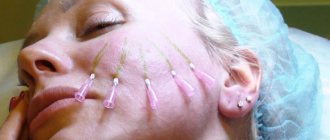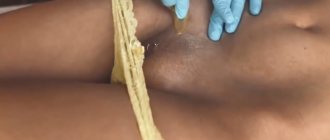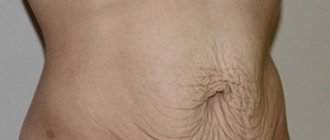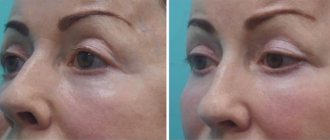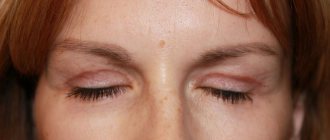Why do you need a bandage after otoplasty?
The main function of the bandage is to securely fix the ears after surgery and protect them from damage. It is important to keep the new one
the shape of the shells, to prevent the appearance of scars or scars in the seam area.
It is necessary to wear a bandage for the following purposes:
- preventing the inflammatory process;
- maintaining the result of plastic surgery;
- relieving postoperative swelling;
- accelerating tissue regeneration;
- protect ears from damage and infection;
- eliminating bruises.
The bandage secures cotton swabs soaked in special oil. It is important to choose the right size so that the material does not squeeze your head. To achieve the desired result, you must strictly follow all recommendations during the rehabilitation period. It is recommended to follow the following rules:
- You can't wash your hair. The product may get into an open wound; you need to wait for the doctor's permission. If necessary, use dry shampoo.
- You should sleep on your back. Incorrect position during rest involuntarily distorts the shape. To do this, it is recommended to slightly raise the head of the bed.
- Wear the bandage at night. This measure prevents your hands from accidentally touching the damaged areas.
- Limit physical activity. Excessive pressure should not be allowed for six months.
- Put the glasses aside. The arches can cause infections when they get into an open wound.
We recommend reading about earlobe plastic surgery. You will learn about the indications and contraindications for the operation, the technique of performing it, the results before and after, and the cost. And here is more about the unusual otoplasty - elf ears.
Types of otoplasty
Otoplasty can be aesthetic or reconstructive.
Aesthetic, as a rule, implies a minor intervention: during the operation, the surgeon eliminates the external defect by changing the location, size or shape of the auricle. The operation takes from 30 minutes to 2 hours.
Reconstructive otoplasty is aimed at complete or partial restoration of the lost/absent auricle (a graft (cartilage material) from the patient’s rib is used as a reconstructive material). The period of reconstructive correction is divided into several stages - the formation of ear cartilage as the basis of the future ear, the formation of the auricle itself and the final aesthetic correction. The total duration of all manipulations is about a year.
The operation is performed both under general anesthesia (for example, for children) and under local anesthesia (for adults). The surgical technique is chosen by the surgeon based on the task. Auricular plastic surgery as an aesthetic operation does not affect hearing function in any way.
Types of compression bandages for ears
There are several types of dressings that are used at different stages of the recovery process. The following types are distinguished:
- open compression bandage on the ears;
- mask.
Compression
The standard elastic version is recommended to be worn immediately after surgery. During this period, it is important to take care of the hygiene and condition of wounds in the ear area. A special fabric is impregnated with an antibacterial solution and protects wounds from infection. Elastic material does not put excessive pressure on the head and protects against mechanical damage. The advantages of this type are the following:
- head mobility is maintained;
- not hot;
- The fabric allows air to pass through well.
Compression bandage for ears after otoplasty
Mask
The closed headband secures the new shape of the ears tightly thanks to the Velcro around the neck. During sleep, the mask protects against accidental head movements. The hypoallergenic material does not cause irritation, the light structure of the fibers has a deodorizing effect. However, there is one drawback - in the summer, wearing a mask is very hot. This may negatively affect the regeneration process.
Bandage-mask for ears after otoplasty
Advantages of the EMC Clinic
EMC Aesthetic Clinic is a leading Moscow clinic in the field of cosmetology and plastic surgery. EMC has been providing medical services for more than 27 years, strictly observing international protocols and representing the highest level of medicine.
The high professional skills of EMC specialists allow us to deal with the most complex cases and show amazing results in our work. The appearance of the ears and hearing acuity do not always radically change life, but they always affect its quality. Correction, reconstructive restoration of the auricles, restoration of hearing function, EMC’s task is to help its patients in any situation at the highest level of medical capabilities.
Can I use an elastic bandage?
Quite often the question arises about the possibility of replacing a bandage with a simple elastic bandage, which is found in every home. This is highly discouraged for several reasons:
- No fasteners . The special bandage has Velcro for fixing it on the head. Often the bandage is not wrapped tightly enough or too loosely. The stable position of the ears is not maintained.
- The skin doesn't breathe. It will take a significant amount of material to wrap your head. As a result, the closed surface will be poorly ventilated, which may affect the regeneration process.
- Not entirely practical . A special bandage will look much better on your head than a regular bandage.
- Not very convenient . It is quite difficult to guess the required tension and size of the material to provide sufficient comfort.
To learn how to properly apply a gauze bandage to your ears after otoplasty, watch this video:
Microtia
Microtia is underdevelopment or absence of the ear. Microtia can be either unilateral or bilateral.
The degree of microtia can vary - from the presence of small congenital defects (too narrow or absent external auditory canal, disproportion of one ear to the other) to a rudimentary ear (absence of the ear canal and eardrum). The complete absence of the auricle is called anotia.
Reconstructive ear otoplasty for microtia allows you to recreate the normal shape and size of the auricle, including the formation of a cartilaginous frame and ear block. After correction of the shape of the auricle, we can also talk about the possibility of restoring hearing function.
EMC employs a team of specialists unique in their professional skills (otorhinolaryngologists, audiologist, audiologist-hearing prosthetist, ENT surgeons), which allows us to use the most innovative methods of hearing restoration, including hearing aids using modern hearing prostheses.
How long to wear the ear bandage
For the first six days after surgery, it is mandatory to wear a compression bandage. It is fixed around special patches or soaked in solution
Sutures after otoplasty
gauze. Within two weeks, examination and dressing are carried out. The stages are as follows:
- The first one is put on a day after otoplasty. Analysis of the results obtained allows us to foresee possible complications.
- The second dressing is after 8 days. The special suture material dissolves or is removed by the surgeon.
It is forbidden to carry out such manipulations yourself. After just a week, you are allowed to wear the bandage only before bed. This must be done within one month to avoid damaging the seams. After six months, complete restoration of cartilage occurs.
During this period, you should limit physical activity and wear a bandage to avoid any damage.
Preparing for surgery
Before undergoing otoplasty, you must undergo a mandatory examination, including blood tests, urine tests, sugar levels, an ECG, as well as a mandatory consultation with an anesthesiologist. You can undergo all necessary tests and preoperative examinations at the EMC clinic.
Before surgery, it is prohibited to take aspirin and medications containing it. A week before surgery, avoid salty, spicy, and smoked foods.
10 days before surgery you must refrain from smoking.
Where to buy a bandage and bandage
You can purchase this product at any pharmacy. The average price for a bandage is 1000 - 1500 rubles . Various colors allow you to choose the appropriate option for daily wear. It is recommended to pay attention to the size before purchasing. The fabric should fit loosely on your head. Excessive pressure causes pain and bleeding in the suture area.
We recommend reading about laser otoplasty. You will learn about the types of otoplasty, indications for laser ear correction, methods of performing it, before and after results, and cost. And here is more information about surgery for protruding ears.
Correction of ear asymmetry
Asymmetry of the ears is quite common. If the patient considers the asymmetry to be too noticeable, then the most effective solution would be to perform otoplasty, correcting the proportionality of the ears.
If the patient is dissatisfied with the shape of only one ear, then, depending on the professional opinion of the surgeon and the desire of the patient, otoplasty can be performed on both one and two ears - to achieve maximum symmetry.
Plastic surgery is also performed for congenital hypertrophy of the earlobes (disproportion between the earlobes and the auricle), a rare but also common problem.
How to choose?
The main thing when choosing a fixation product is to take into account the volume of the head and choose the appropriate size. There is no need for the patient to make the selection on their own - it is enough to consult with your surgeon before the operation, and the doctor will select the optimally suitable item.
Patients often ask whether it is possible to use an elastic bandage instead of a fixing bandage. Unfortunately, bandaging does not help to fully realize the required functionality of the sling. The main problem with using a bandage is the difficulty with applying pressure. Strong compression can injure the ears, and weak compression cannot keep the shells from moving.
It is not recommended to tie your head with a bandage instead of a bandage.
In addition, a bandage is a rather impractical and even unaesthetic thing. Therefore, it is recommended to use exclusively a specialized product, as it is practical and functional.
Possible complications
Complications after surgery themselves are quite rare. The most common cause of complications is the patient’s negligence in caring for the injured area during the rehabilitation period. If the rules of the rehabilitation period are violated, the following problems are possible:
- displacement of shells,
- asymmetry,
- infection or inflammation
- formation of noticeable scars.
It is worth noting that swelling and bruising in the intervention area are not complications, but normal postoperative phenomena. These effects go away on their own during the recovery period.
If the patient has any unusual symptoms, such as a high fever for several days or severe pain in the surgical area, then you should consult a doctor as soon as possible.
Answers to patient questions
How long do my ears hurt after surgery?
Pain after otoplasty is quite natural and may bother the patient for a short time. The pain is easily relieved by taking conventional analgesics and, together with swelling, completely ceases to bother you after 1 week.
Are the seams noticeable?
To see the seam on the fold behind the ear, you need to try hard! The thin mark after the incision becomes invisible after complete healing. However, you should not neglect wearing a fixing bandage for the prescribed period.




